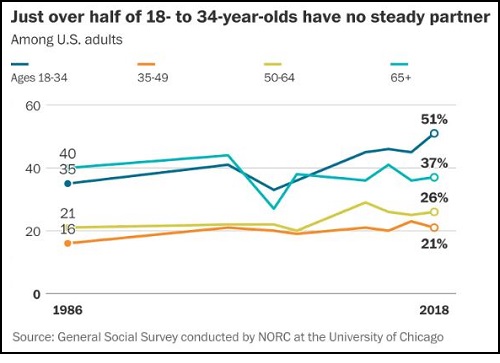
|
|

|
|
| April 25, 2024 |
|
More than half of young people in America don’t have a romantic partner 
Austin Spivey, a 24-year-old woman in Washington, has been looking for a relationship for years. She’s been on several dating apps, OkCupid, Coffee Meets Bagel, Hinge, Tinder, Bumble. She’s on a volleyball team, where she has a chance to meet people with similar interests in a casual setting. She’s even let The Washington Post set her up.
“I’m a very optimistic dater,” Spivey says, adding that she’s “always energetic to keep trying.” But it can get a little frustrating, she adds, when she’s talking to someone on a dating app and they disappear mid-conversation. (She’s vanished too, she admits.) Spivey has a lot of company in her frustration, and in her singledom. Just over half of Americans between the ages of 18 and 34 — 51 percent of them — said they do not have a steady romantic partner, according to data from the General Social Survey released this week. That 2018 figure is up significantly from 33 percent in 2004, the lowest figure since the question was first asked in 1986, and up slightly from 45 percent in 2016. The shift has helped drive singledom to a record high among the overall public, among whom 35 percent say they have no steady partner, but only up slightly from 33 percent in 2016 and 2014. There are several other trends that go along with the increase in young single Americans. Women are having fewer children, and they’re having them later in life. The median age of first marriage is increasing. And according to a 2017 report from the Pew Research Center, among those who have never married but are open to it, most say a major reason is that they haven’t found the right person. Of course, not everyone who’s under 35 and single is looking to change that. Caitlin Phillips, a 22-year-old student at the University of Georgia, is open to love if it walked into her life, but she’s not actively looking for it. “I’m too busy, honestly. I travel a lot and I have a great group of friends that I hang out with,” Phillips said in a phone interview, adding that she’s working in addition to studying for a degree in journalism. The GSS survey reflects similar trends from the federal Current Population Survey as analyzed by the Pew Research Center. The CPS data asked about living with a spouse or partner as opposed to simply having one. The Pew analysis found 42 percent of American adults who did not live with a spouse or partner in 2017, up from 39 percent in 2007. It also found an increase in the share of adults under 35 who didn’t live with a spouse or partner over that period, from 56 percent to 61 percent. According to the General Social Survey data, 41 percent of Democrats are without a steady partner, compared with 29 percent of Republicans. Black Americans are more likely than white Americans to not have a steady partner: 51 percent vs. 32 percent, respectively. The share of non-partnered Americans is also higher among those unemployed, 54 percent, up from 44 percent in 2016. Just under a third, 32 percent, of employed adults don’t have a steady partner. The General Social Survey was conducted by NORC at the University of Chicago using in-person interviews of a random national sample of 2,348 adults from April 12 to Nov. 10, 2018. Results on the partner question is based on a subsample of 1,181 interviews and has a margin of sampling error of plus or minus 3.5 percentage points. (Source: The Washington Post) Story Date: March 25, 2019
|